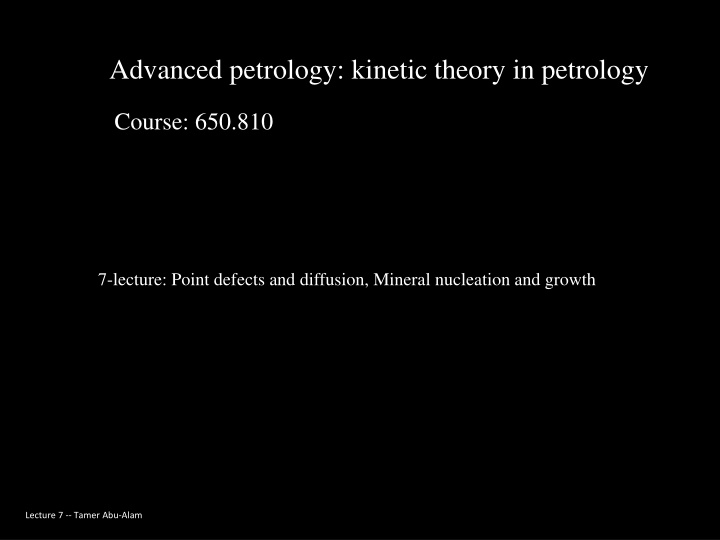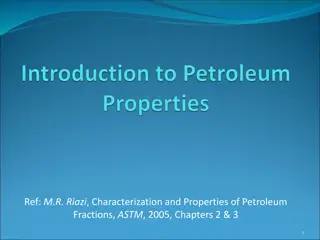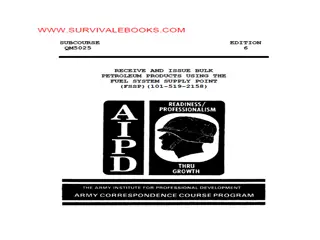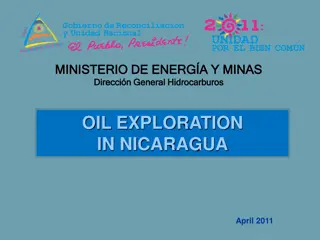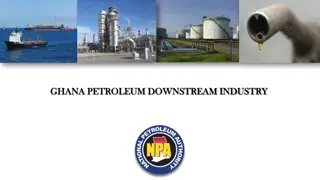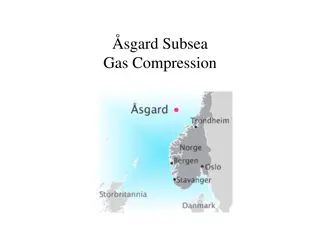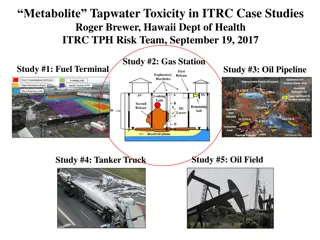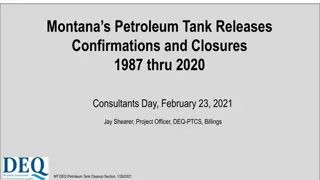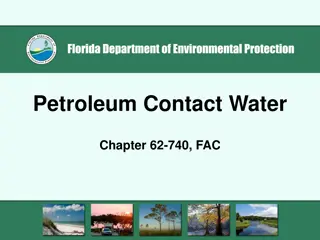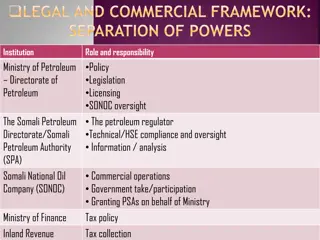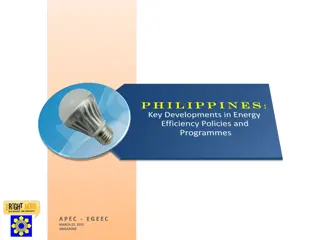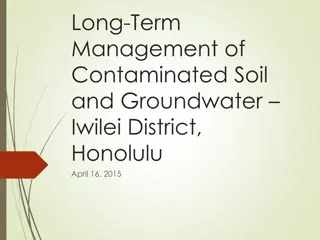Petroleum: A Vital Energy Source
Petroleum, also known as crude oil, is a crucial energy source that has deep historical roots. It plays a significant role in powering the world and is obtained through seismic surveys and drilling. The process of fractional distillation is used to extract valuable substances like gasoline. While petroleum offers advantages such as abundance and reliability for transportation, it has drawbacks like non-renewability and environmental damage. Despite its importance, the finite nature of petroleum necessitates sustainable energy solutions for the future.
Download Presentation

Please find below an Image/Link to download the presentation.
The content on the website is provided AS IS for your information and personal use only. It may not be sold, licensed, or shared on other websites without obtaining consent from the author.If you encounter any issues during the download, it is possible that the publisher has removed the file from their server.
You are allowed to download the files provided on this website for personal or commercial use, subject to the condition that they are used lawfully. All files are the property of their respective owners.
The content on the website is provided AS IS for your information and personal use only. It may not be sold, licensed, or shared on other websites without obtaining consent from the author.
E N D
Presentation Transcript
Advanced petrology: kinetic theory in petrology Course: 650.810 7-lecture: Point defects and diffusion, Mineral nucleation and growth Lecture 7 -- Tamer Abu-Alam
Yakov Frenkel (or, sometimes, Jakov or Jacov) proposed in 1926 and then elaborated the idea of diffusion in crystals through local defects (vacancies and interstitial atoms). He introduced several mechanisms of diffusion and found rate constants from experimental data. Later, Nowadays, it is universally recognized that atomic defects are necessary to mediate diffusion in crystals Lecture 6 -- Tamer Abu-Alam
Crystal defects The periodic crystal structure of solid crystal can be defected by four types of defect. Point defects Line defects Planar defects Bulk defects Point defects: Defects in the periodic structure of a crystal caused by the absence of an atom or ion at a lattice site (vacancy), the presence of an additional atom in an interstitial position, or the presence of a foreign ion at a lattice site (impurity) Lecture 7 -- Tamer Abu-Alam
Crystal defects Point defects Taking into account the restriction of electroneutrality. When an ion is removed from a lattice Site, the crystal acuires a charge imbalance. This imbalance must be corrected if Electroneutrality is to be mantained. In a simple ionic crystal there are two dominant types of intrinisc defects 1- Schottky defect Anti-Schottky defect 2- Frenkel defect Anti-Frenkel defect Lecture 7 -- Tamer Abu-Alam
Crystal defects Line defects: are linear defects around which some of the atoms of the crystal lattice are misaligned. There are two basic types of line defects, the edge defect and the screw defect. "Mixed" defects, combining aspects of both types, are also common. Edge defects are caused by the termination of a plane of atoms in the middle of a crystal. In such a case, the adjacent planes are not straight, but instead bend around the edge of the terminating plane so that the crystal structure is perfectly ordered on either side. Lecture 7 -- Tamer Abu-Alam
Crystal defects http://www.youtube.com/watch?v=dvDankgGBIs Lecture 7 -- Tamer Abu-Alam
Crystal defects Planar defects Grain boundaries Lecture 7 -- Tamer Abu-Alam
Crystal defects Planar defects Twin Boundaries Lecture 7 -- Tamer Abu-Alam
Crystal defects Bulk defects Voids are small regions where there are no atoms, and can be thought of as clusters of vacancies. Impurities can cluster together to form small regions of a different phase. These are often called precipitates. Lecture 7 -- Tamer Abu-Alam
Macroscopic types of diffusion Surface diffusion Grain boundary diffusion Volume diffusion Diffusion coefficient of surface diffusion > Diffusion coefficient of grain boundary diffusion > Diffusion coefficient of volume diffusion Lecture 7 -- Tamer Abu-Alam
Mineral B Mineral B Mineral A Mineral B Mineral A Lecture 7 -- Tamer Abu-Alam
Composition of A Mineral B Diffusion to form A Mineral B Mineral A Mineral B Mineral A This diffusion is controlled by the Fick law and it can be diffusion along the surface or grain boundary or the volume Lecture 7 -- Tamer Abu-Alam
Along the grain boundries the diffusion coefficent is higher than inside the grains as well at the grain boundries there is surface energy. The best plase to start the nucleation is at this place. In thermdynamic terms: What is the driving force to do that? It is the chemical potential or to make it simple it is the Gibbs free energy G = H TS Lecture 7 -- Tamer Abu-Alam
In thermdynamic terms: What is the driving force to do that? It is the chemical potential or to make it simple it is the Gibbs free energy G = H TS dG = dH T dS At equilibrium dG = 0 0 = dH Te dS dH = Te dS Where the Te is the equilibrium temperature dG = Te dS T dS dG = dS (Te T) (Te T) is the super-cooling temperature Lecture 7 -- Tamer Abu-Alam
It is not a 2D process but it is 3D process ? = 4? ?3 ? + 4? ?2 ? 3 Where W the work required to grow the mineral, r is the radius of the mineral and ? is the surface energy Lecture 7 -- Tamer Abu-Alam
4? ?2 ? ? ? ? 4? ?3 ? 3 ? = 4? ?3 ? + 4? ?2 ? 3 Lecture 7 -- Tamer Abu-Alam
4? ?2 ? ? To grow a mineral from r1 to r2, you spend more energy in the surface than the energy you get from the volume W* ? r1 r2 r* To grow a mineral you need a nucleus with radius r* ? 4? ?3 ? 3 How can we get r* and W*? Lecture 7 -- Tamer Abu-Alam
How can we get r* and W*? ? = 4? ?3 ? + 4? ?2 ? 3 4? ?2 ? ? ?? ??= 4? ? 2 ? + 8? ? ? ?? ??= 0 W* ? 4? ? 2 ? = 8? ? ? r1 r2 r* ? ? = 2? 2? ? ? = ? 4? ?3 ? 3 Lecture 7 -- Tamer Abu-Alam
How can we get r* and W*? ? = 4? ? 3 ?? + 4? ? 2 ? 3 4? ?2 ? ? 2? ?? ? = W* (?3 ???2) ? 16? 3 r1 r2 r* ? = What will happen if we change the temperature? ? dG = dS (Te T) 4? ?3 ? 3 ? = If Te = T --- the dG = 0 ? = We need super-cooling to form a new mineral Lecture 7 -- Tamer Abu-Alam
Strain term 4? ?2 ? ? W* ? r1 r2 r* ? ? = 4? 4? ? 3 ?? ???2 + 4? ? 2 ? ?3 ? 3 3 Where C is composition difference between new mineral and ground matric, K is bulk moduls and ? is shear strain Lecture 7 -- Tamer Abu-Alam
